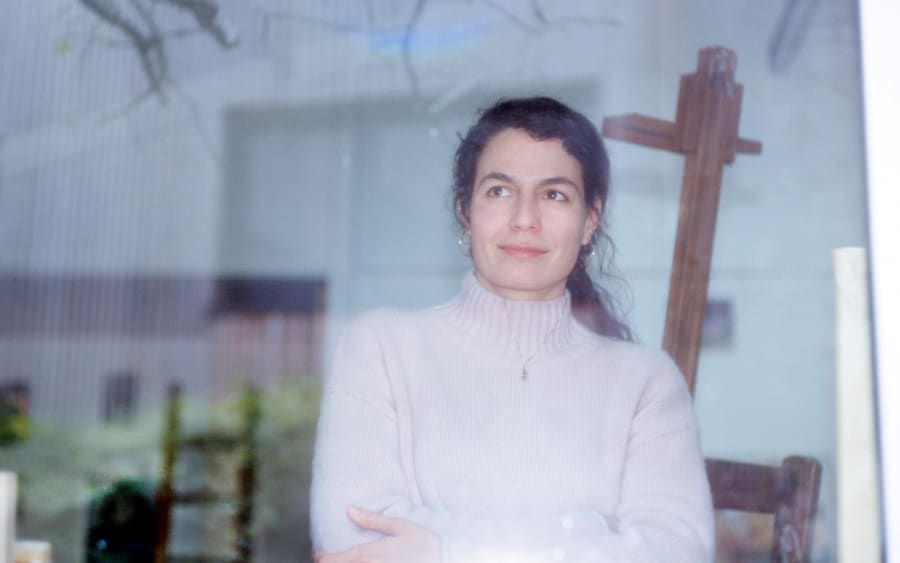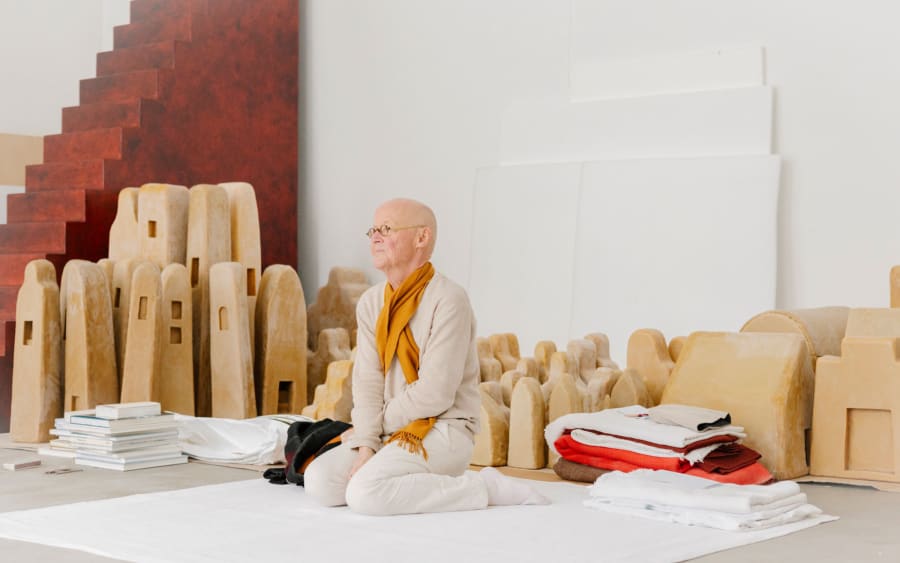For a long time, Gisèle Vienne refused to choose. As a child, she was fascinated by everything: music, which she began learning at the age of six, sculpture and painting (a family affair for a girl whose mother was a visual artist), and a whole range of artisanal crafts, from engraving to bookbinding. All were embraced with the same exacting standards. ‘My parents did not have a lot of money, so if I saw something I liked, my mother and I would make it,’ she recalls.
Later came dance, rock and roll, and gymnastics. Then, in high school, a decisive encounter with literature and philosophy: Georges Bataille, Michel Foucault, and Hannah Arendt. ‘I turned to philosophy after high school, but I continued all these other practices on the side.’ This woman, who looks like she was once a well-behaved child, now stands before us as one of the most influential artists shaking up the contemporary scene. Now a choreographer and stage director, Vienne is celebrated for her uncompromising vision that wrenches the guts and twists certainties.
She encapsulates her aim and her quest in a single phrase: to ‘displace perceptual frameworks’ – those we have inherited and internalized to the point of considering them normal. In the course of her shows, the artist prompts us to ask questions: What do we see first, or not at all? What is audible and legible, and what remains as noise? Who is speaking, and from where? Little by little, we begin to realize that nothing can be taken for granted, that very few things are neutral, and that almost everything reflects a shared communion in the perceptible. Is anything inevitable? Absolutely not, because everything could just as easily be otherwise: Change is a question of aesthetics before all else.
We are in a café in the 10th arrondissement of Paris, a stone’s throw from the theaters on the Faubourg Saint-Antoine, discussing Vienne’s first artistic experiences. We could just as well have met in Grenoble or Geneva, where her latest stage creation, EXTRA LIFE, toured earlier this year. The performance, which premiered in mid-August last year at the Ruhrtriennale in Germany, amplifies, diffracts, and displaces Vienne’s methods. Little by little, interweaving her skills, the Franco-Austrian artist subtly submerges us in troubled waters. We find ourselves in a kind of apnea where certainties disappear in a hallucinatory haze pierced by lasers, and where space-time dissolves in the sweaty, rhythmic sensuality of electronic pulsing.
The story at the heart of this production must be stated clearly and from the start. It is one of the oldest stories in the world, repeated like a mortifying refrain, yet relegated to invisibility and the unspeakable. A brother and sister come face to face twenty years after the trauma of incest. The show begins with a car in a parking lot, headlights on. It is the end of a party, and we recognize the artist’s penchant for seedy atmospheres full of possibility: free parties, hooded teens, urban concrete. Early morning is approaching, and a process is already underway: they will do everything in their power to conjure up the past and attempt to be reborn together. ‘Those who dominate others constantly work to legitimize the existing order, which benefits them, and to create amnesia,’ says the artist.
The theme of incest is present throughout much of her repertoire, from Éternelle Idole (2009) to This Is How You Will Disappear (2010), Crowd (2017), and L’Étang (2021). It is impossible to articulate the subject once and for all – in other words, it has to be reworked over and over again: ‘That is also why this cross-disciplinary approach to the arts is necessary to move things forward.’ The little girl who refused to choose is still there, but this interdisciplinarity has become a formal commitment for the choreographer.
In the end, Vienne felt most at home in contemporary dance. Her introduction to the stage, however, took a circuitous route: After studying philosophy, Vienne surprisingly opted to go to a specialist school to learn puppetry. The world of puppeteering connected for her to another scene she had frequented during her adolescence: contemporary art. ‘I grew up and lived in Grenoble until 1993. The art scene there was very rich, with Le 102, Rue d’Alembert, the Beaux-Arts school, where I hung out with artists, and Le Magasin, where I worked setting up exhibitions and in the archives department. When we went to Austria on vacation, my mother also took me to see exhibitions in Switzerland. That is where I discovered Jean Tinguely, Cindy Sherman, Christian Boltanski, and, a little later, Mike Kelley. For me, puppetry was totally Sherman and Kelley!’
At the Institut International de la Marionnette in Charleville-Mézières, Vienne rediscovered with the manual side of creation that she had missed in philosophy and music: ‘I needed a connection to phenomena, to gestures, and to physicality.’ In this environment torn between tradition and renewal, she became interested in stage directing. Obsessed by the writings of Jean Genet and under the spell of encounters with dancers, she eventually realized a growing desire: ‘At the age of twenty-three, I found myself at P.A.R.T.S. (Performing Arts Research and Training Studios), Anne Teresa De Keersmaeker’s studios in Brussels. I thought to myself that I had finally found something at the intersection of all my passions, and which would allow me to work collaboratively.’ From the vantage point of contemporary art, the ease with which she combines disciplines is astonishing. Indeed, a number of artists told her as much when they saw performances of her very first pieces: ‘When I created This Is How You Will Disappear (2010), Dominique Gonzalez-Foerster, Philippe Parreno, and Pierre Huyghe expressed their enthusiasm for my work, particularly because it takes part in a shared history with their own work.’
With regard to contemporary art, her position is clear. ‘Due to the technical infrastructure of museums, I only rarely give performances in that setting. On the other hand, many people from the contemporary art world come to see my shows. I also love showing my work in public museums: from the Whitney Biennial in New York to the Centre Pompidou (both 2012), Les Abattoirs, Toulouse (2018), the Museo Nacional de Bellas Artes in Buenos Aires (2019), the Musée d’Art Moderne de Paris (2021), and next September, at the Haus am Waldsee and the Georg Kolbe Museum in Berlin.’ Audiences and institutions may well be porous, but there remain distinctions between ways of working: ‘A dance company is exciting – it allows you to come face to face with the reality of salaried work.’ Hearing her unfold her story in order to better clarify her positions, one understands that Vienne will continue to search, dig, and refine. Likewise, that her intransigence will remain unshakeable: ‘I was the same way 20 years ago. Being upright in our artistic gestures and aware of their political dimension is all the more crucial today.’ In a parting shot, she adds, ‘I make rigorous formal work. And I do it that way because that is how to move society.’
EXTRA LIFE will be presented at the Théâtre Vidy-Lausanne, June 12, 13, 15, and 16, 2024.
Ingrid Luquet-Gad is an art critic and PhD candidate based in Paris. She teaches art philosophy at the University Paris 1 Panthéon-Sorbonne.
Credits of the top image: Crowd (2017). Design: © DACM / Gisèle Vienne. Photograph : © Estelle Hanania
English translation: Jacob Bromberg.
Published on April 3, 2024.


